Your driveway serves as the first impression of your home, making thoughtful landscaping essential for maximizing curb appeal and property value. Modern driveway design goes beyond simple functionality, incorporating sustainable materials, native plantings, and creative lighting solutions that transform this utilitarian space into an attractive focal point. Today's homeowners are embracing eco-friendly permeable surfaces, sophisticated edging techniques, and multi-seasonal plant selections that provide year-round interest while requiring minimal maintenance. Whether you have a straight, curved, or circular driveway, strategic landscaping can enhance your home's architectural style while addressing practical concerns like drainage and vehicle clearance.
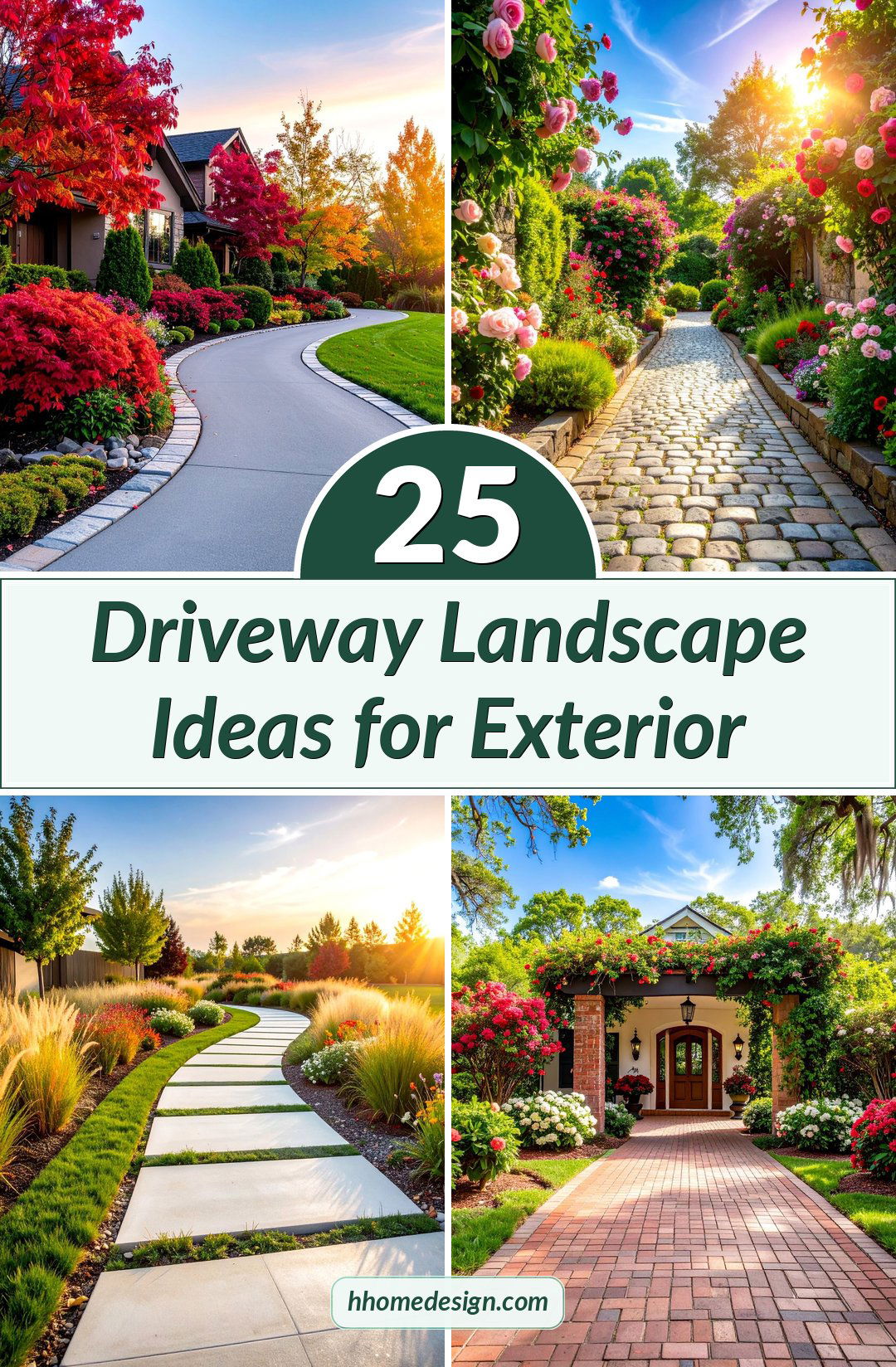
1. Circular Driveway with Center Fountain Display

A circular driveway featuring a central fountain creates an elegant estate-like entrance that immediately elevates your property's sophistication. The fountain serves as a stunning focal point while the surrounding planted bed can showcase seasonal flowers, evergreen shrubs, and ornamental grasses for year-round appeal. Belgian block or natural stone edging defines the planting area and prevents vehicles from encroaching on the landscape. Consider incorporating drought-tolerant perennials like lavender, ornamental sage, and black-eyed Susans around the fountain's perimeter, as these plants thrive in the reflected heat from paving while providing continuous blooms. Integrated LED lighting illuminates both the water feature and surrounding plantings for dramatic evening appeal.
2. Gravel Driveway with Permeable Border Gardens

Gravel driveways paired with permeable border gardens offer an environmentally conscious solution that manages stormwater while creating natural beauty. Install raised planting beds along both sides using recycled concrete blocks or natural stone, filling them with native plants that filter runoff and support local wildlife. Ornamental grasses like fountain grass, little bluestem, and buffalo grass provide texture and movement while requiring minimal water once established. The gravel surface allows water infiltration, reducing environmental impact while the planted borders prevent stone migration. Consider using locally sourced gravel in neutral tones that complement your home's exterior, edged with metal or composite materials for clean lines and easy maintenance.
3. Modern Concrete Driveway with Succulent Strip Plantings
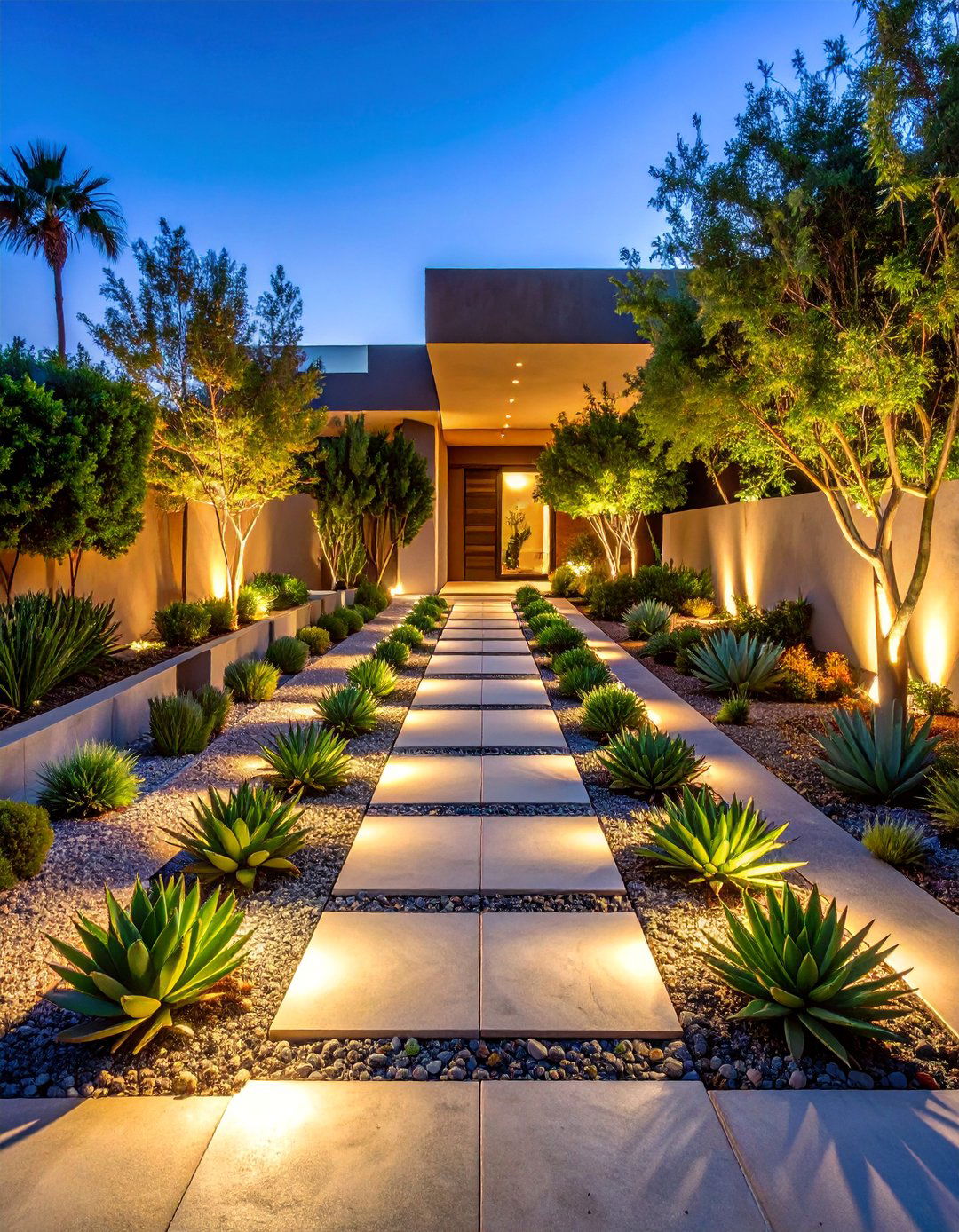
Contemporary concrete driveways enhanced with linear succulent plantings create striking geometric patterns that align with modern architectural styles. Install narrow planting strips between concrete ribbons or along edges, filling them with drought-resistant succulents like agave, sedum varieties, and ornamental aloe. The contrast between smooth concrete surfaces and textured plant forms adds visual interest while requiring virtually no irrigation once established. Decomposed granite or decorative stone mulch complements the succulent plantings while preventing weed growth. Integrated LED strip lighting along the planting edges provides safety illumination and highlights the architectural plant forms after dark. This design approach works particularly well in arid climates and contemporary home settings.
4. Curved Driveway with Layered Shrub Borders
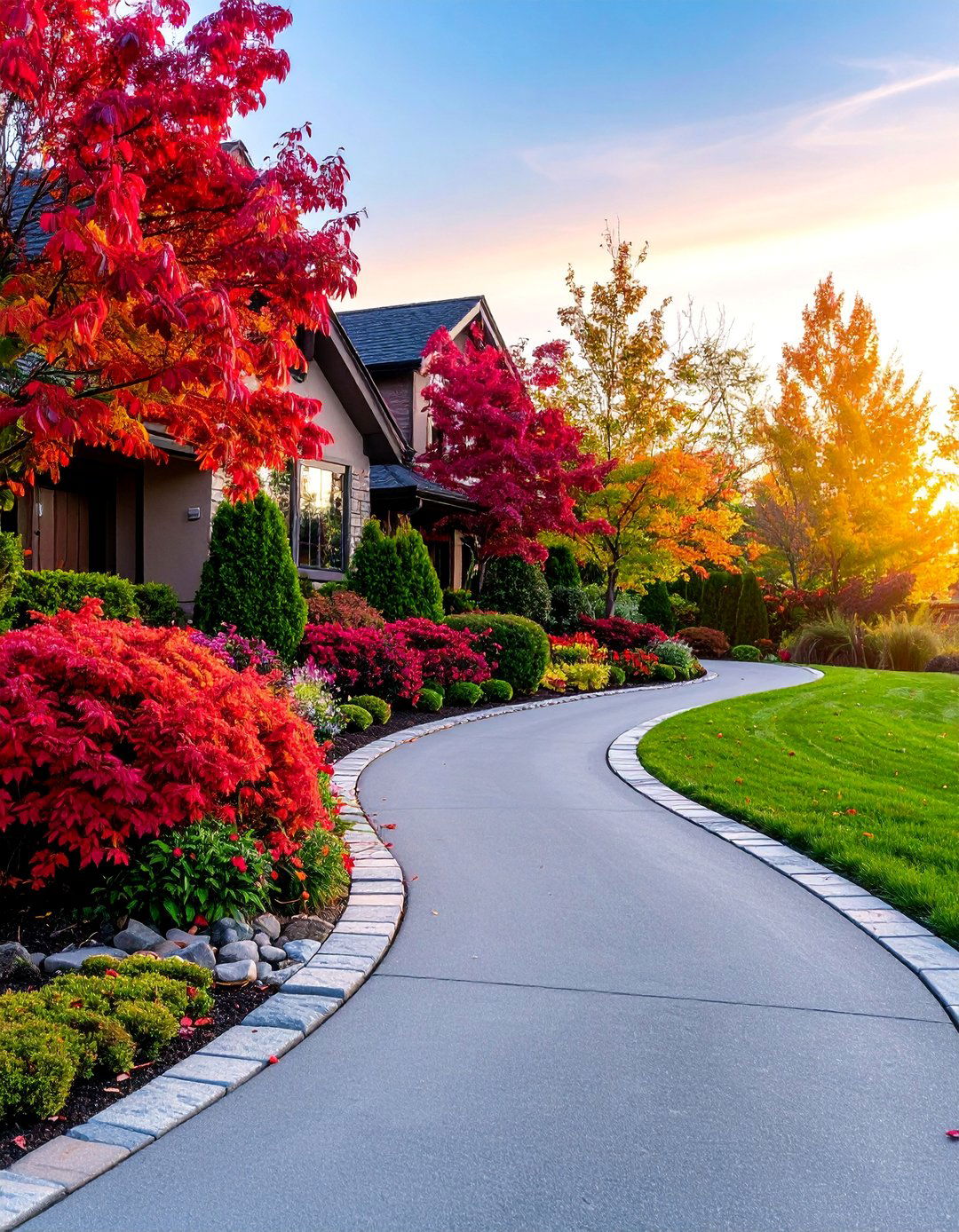
Curved driveways benefit from layered shrub plantings that follow the natural flow while creating depth and visual interest throughout the seasons. Plant tall background shrubs like lilac, viburnum, or native serviceberry, followed by medium-height specimens such as spirea, hydrangea, or native azaleas. Complete the composition with low-growing groundcovers like creeping phlox, wild ginger, or native sedums along the driveway edge. This tiered approach provides privacy screening, seasonal flowers, and fall color while accommodating vehicle clearance requirements. Use natural stone or brick edging to define planting areas and prevent encroachment onto the driving surface. The layered design ensures year-round structure while offering habitat for beneficial insects and birds.
5. Paved Driveway with Formal Boxwood Hedging

Traditional paved driveways gain timeless elegance through formal boxwood hedging that provides structure and sophistication year-round. Install low-growing boxwood varieties like 'Winter Gem' or 'Green Velvet' along driveway edges, maintaining them at 18-24 inches for vehicle clearance while creating clean architectural lines. The evergreen foliage provides consistent green color through all seasons, requiring only occasional pruning to maintain shape. Enhance the formal design with decorative urn planters at entrance points, filled with seasonal flowers or topiary specimens. Consider brick or stone edging between the hedging and paving to prevent root encroachment and create maintenance strips. This classical approach complements colonial, traditional, and Georgian architectural styles while adding significant property value.
6. Rustic Stone Driveway with Wildflower Meadow Edges

Natural stone driveways bordered by wildflower meadow plantings create a charming cottage-style entrance that celebrates local ecology while requiring minimal maintenance. Select native wildflower seeds appropriate for your region, such as black-eyed Susan, purple coneflower, cosmos, and bachelor buttons for sustained blooms throughout growing seasons. The irregular stone surface provides authentic character while meadow plantings soften harsh edges and support pollinators. Install subtle boulder or timber edging to define planting areas without overwhelming the natural aesthetic. Allow grasses to self-seed within the meadow for authentic texture and winter interest. This approach works especially well for country properties, farmhouse styles, and homes seeking to reduce lawn maintenance while increasing biodiversity.
7. Stamped Concrete Driveway with Ornamental Tree Allée

Stamped concrete driveways featuring an ornamental tree allée create dramatic approaches reminiscent of European estates. Select uniform trees like flowering cherry, crabapple, or maple varieties, spacing them consistently along both sides to frame the entrance. The trees provide seasonal interest through spring flowers, summer shade, and autumn color while the stamped concrete offers durability and design flexibility. Choose patterns that complement your home's architecture, such as cobblestone for traditional styles or geometric designs for contemporary homes. Install adequate root barriers and ensure proper spacing to prevent future pavement damage. Under-plant with shade-tolerant groundcovers like pachysandra, vinca, or native wild ginger for a finished appearance that suppresses weeds naturally.
8. Permeable Paver Driveway with Rain Garden Integration

Permeable paver driveways combined with strategically placed rain gardens manage stormwater while creating beautiful landscape features. Install pavers with gaps filled with grass or decorative stone, allowing water infiltration while maintaining a solid driving surface. Design rain gardens in naturally low areas adjacent to the driveway, filling them with moisture-loving plants like cardinal flower, blue flag iris, and native sedges. These planted depressions capture and filter runoff, reducing flooding while supporting local wildlife. The combination addresses environmental concerns while creating visual interest through plant diversity and seasonal changes. Consider connecting multiple rain gardens with dry creek beds lined with river rock for additional drainage and landscape continuity.
9. Heated Driveway with Winter-Interest Plantings

Heated driveways paired with winter-interest plantings ensure year-round beauty and functionality in cold climates. Install radiant heating systems beneath paved surfaces to eliminate snow removal while surrounding plantings provide color and texture during dormant seasons. Select plants with attractive bark, persistent berries, or evergreen foliage, such as red-twig dogwood, winterberry holly, and ornamental grasses. Evergreen shrubs like rhododendron, mountain laurel, and coniferous varieties maintain structure throughout winter months. The heated surface reduces ice formation around plantings, extending their seasonal appeal while ensuring safe access. Position deciduous ornamental trees to provide summer shade without interfering with the heating system's efficiency.
10. Cobblestone Driveway with English Garden Borders
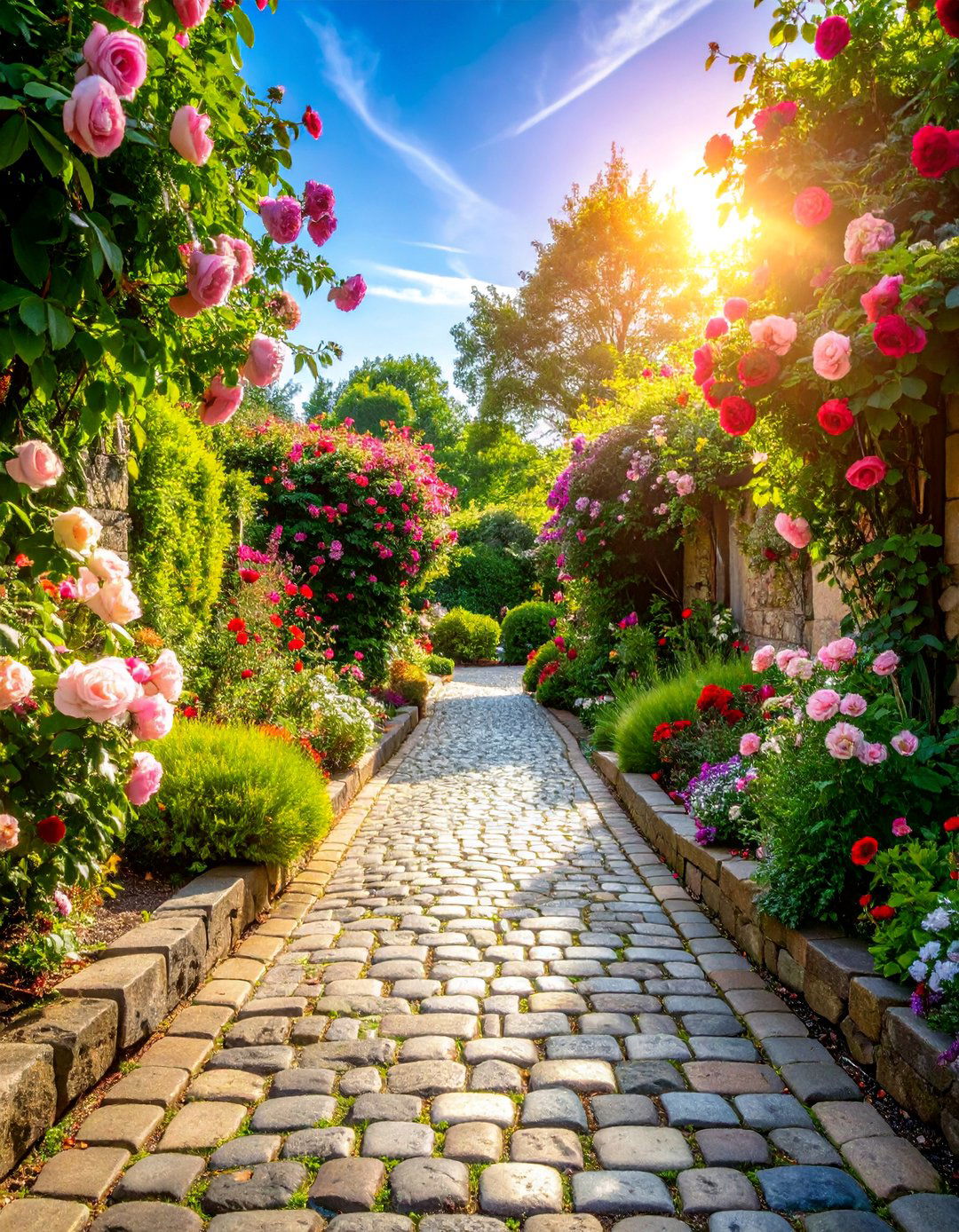
Cobblestone driveways enhanced with English garden-style borders create romantic, old-world charm through mixed perennial plantings and informal design. Install authentic or reproduction cobblestones in traditional patterns, bordered by generous planting beds filled with cottage garden favorites like roses, lavender, catmint, and delphinium. The irregular surface provides character while mixed plantings offer continuous blooms and fragrance throughout growing seasons. Use natural stone or brick edging to define garden areas and maintain clean lines between hardscape and plantings. Include climbing roses or clematis on nearby structures for vertical interest. This approach complements Tudor, English cottage, and traditional architectural styles while creating a welcoming, romantic atmosphere.
11. Asphalt Driveway with Modern Architectural Plantings

Simple asphalt driveways gain contemporary appeal through modern architectural plantings that emphasize form, texture, and seasonal interest. Select plants with strong structural qualities like ornamental grasses, sword-like agaves, and columnar evergreens that complement clean architectural lines. Group plantings in geometric patterns or linear arrangements that echo modern design principles. Use sleek metal or concrete edging to define planting areas and create visual continuity with contemporary home styles. Incorporate lighting at ground level to highlight plant forms and create dramatic shadows after dark. This minimalist approach focuses on plant architecture rather than flowers, creating sophisticated landscapes that complement modern and mid-century home designs.
12. Brick Driveway with Southern Garden Styling
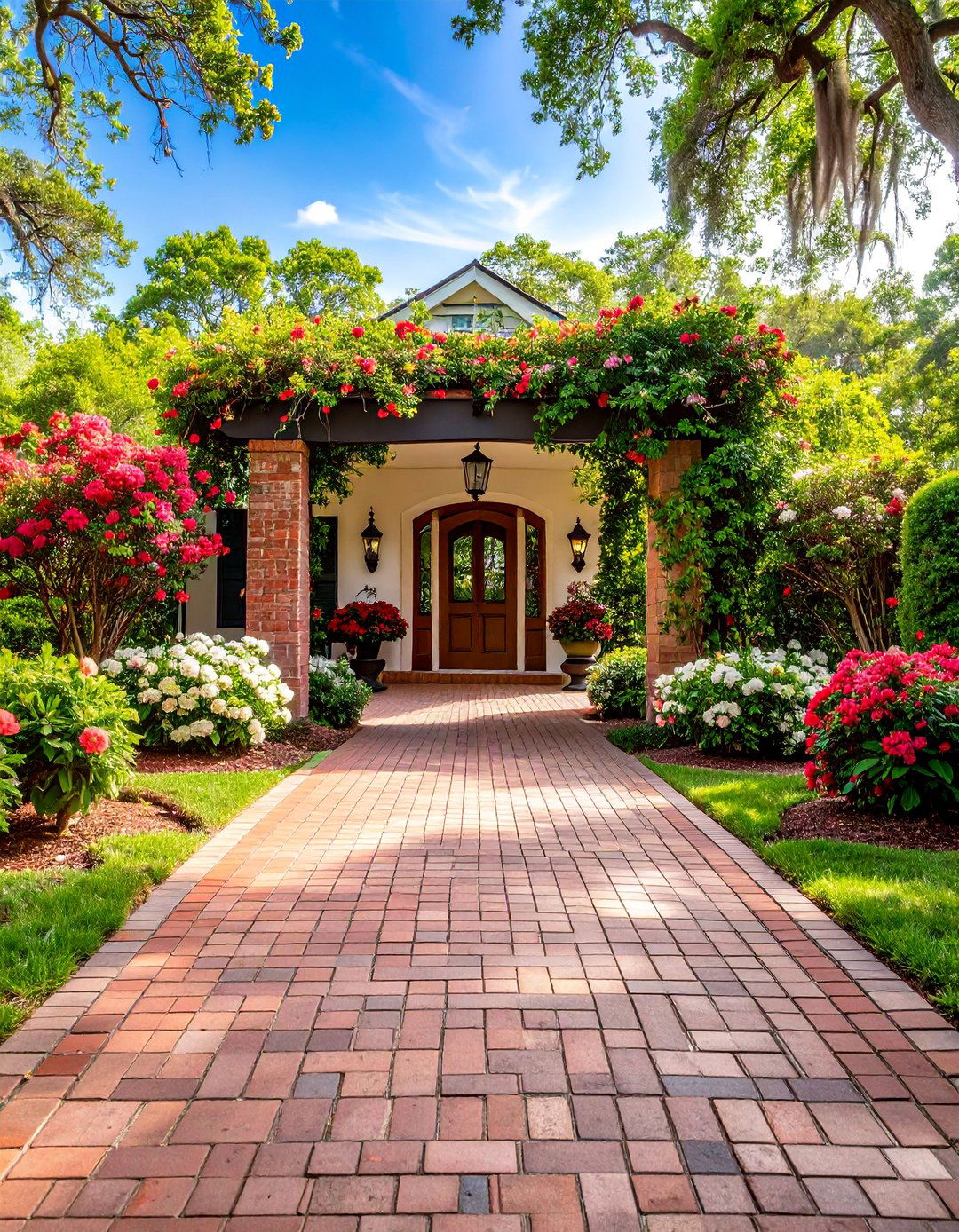
Traditional brick driveways enhanced with Southern garden-style plantings create gracious entrances that celebrate regional character and climate. Install reclaimed or new brick in classic patterns like herringbone or running bond, bordered by heat-tolerant plants such as gardenia, camellia, and azaleas. Include fragrant additions like confederate jasmine, magnolia, and sweet olive for authentic Southern charm. The brick surface provides timeless appeal while plantings offer seasonal flowers and evergreen structure. Consider adding wrought iron details or decorative urns at entrance points for additional elegance. Spanish moss or similar epiphytes on mature trees enhance the regional character. This approach works especially well with colonial, plantation, and traditional Southern architectural styles.
13. Resin-Bound Driveway with Mediterranean Herb Gardens
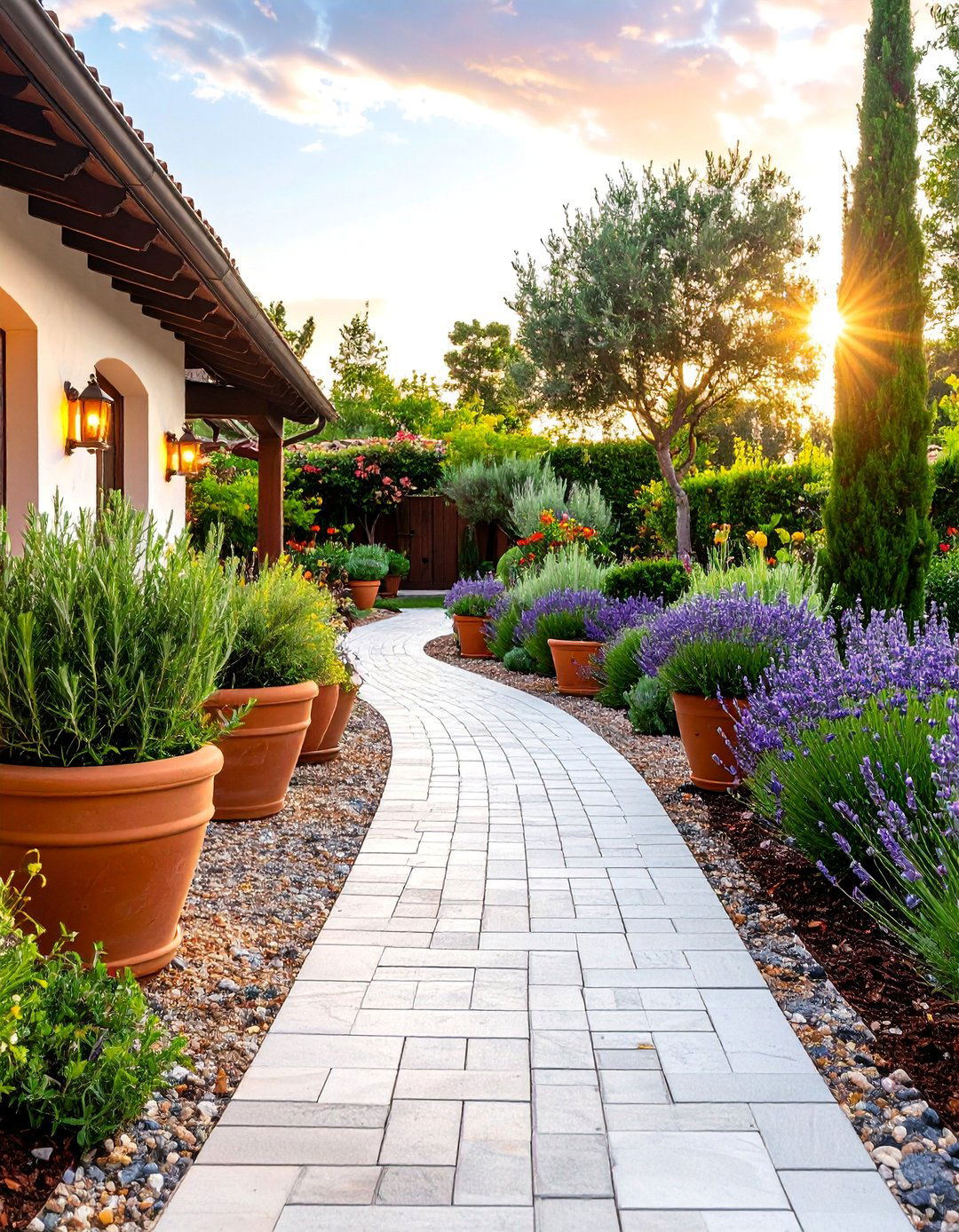
Resin-bound driveways featuring Mediterranean herb gardens create aromatic, low-maintenance landscapes perfect for warm climates. The smooth, permeable surface combines natural aggregates with clear resin for durability and weather resistance while planted borders showcase culinary and ornamental herbs. Install rosemary, lavender, thyme, and oregano along driveway edges, creating fragrant pathways and useful harvests. Silver-leaved plants like artemisia and lamb's ear provide textural contrast while requiring minimal water once established. Terra cotta containers or raised planters enhance the Mediterranean theme while providing drainage for herb cultivation. Decomposed granite pathways between planted areas complete the authentic aesthetic while requiring minimal maintenance.
14. Concrete Ribbon Driveway with Native Prairie Plantings
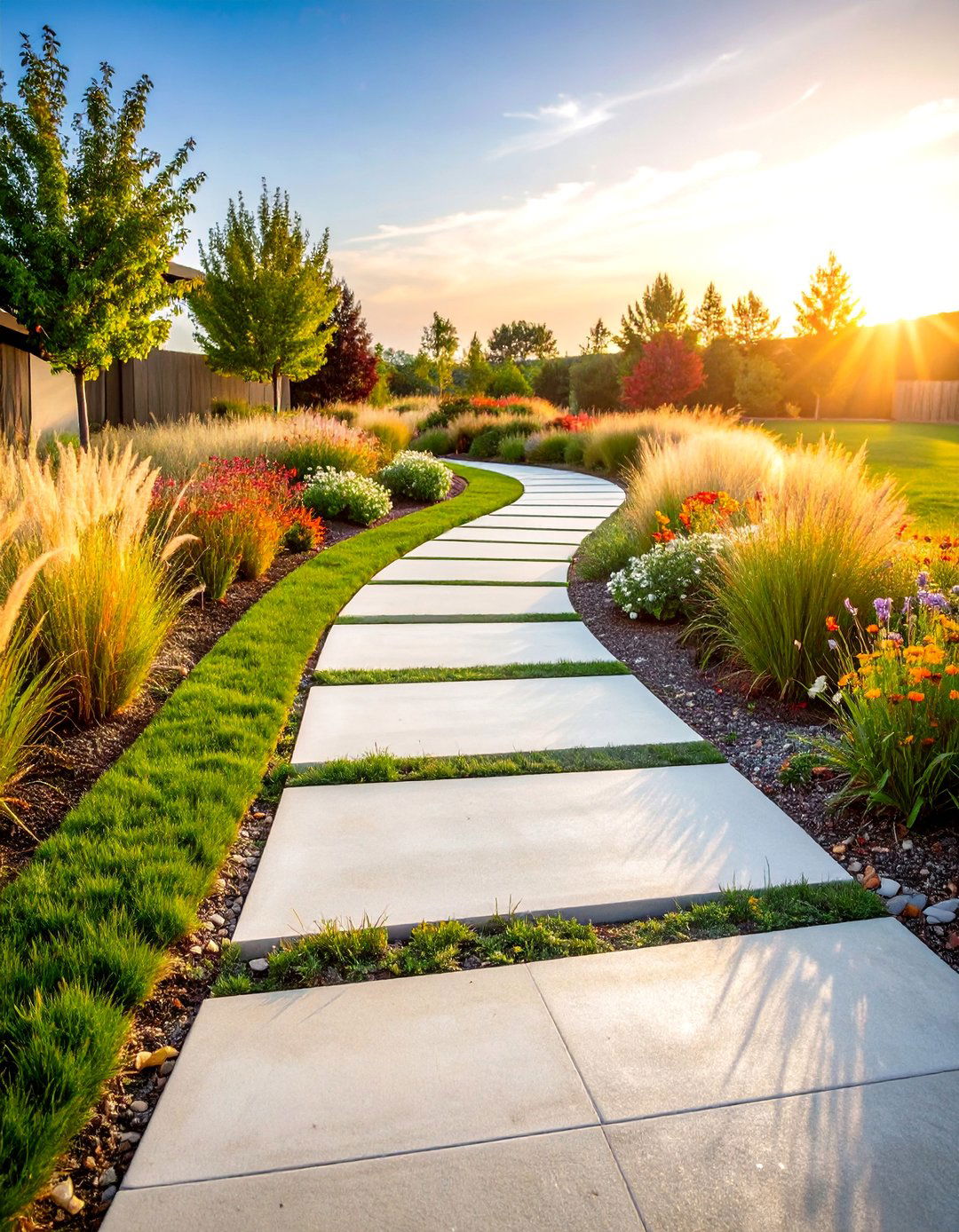
Concrete ribbon driveways surrounded by native prairie plantings create sustainable landscapes that support local ecosystems while reducing maintenance requirements. Install parallel concrete strips with native grass plantings between and alongside, allowing vehicles to track on hard surfaces while maintaining natural character. Select regionally appropriate prairie plants like little bluestem, buffalo grass, purple coneflower, and native asters for seasonal color and wildlife habitat. The design reduces impervious surface area while providing adequate vehicle support and year-round visual interest. Prescribed burning or annual cutting maintains prairie health while preventing encroachment on driving surfaces. This ecological approach works well for contemporary homes and environmentally conscious homeowners seeking sustainable landscape solutions.
15. Decomposed Granite Driveway with Xeriscape Borders

Decomposed granite driveways paired with xeriscape plantings create water-wise landscapes ideal for arid climates and drought-prone regions. The compacted granite surface provides stable, dust-free driving while surrounding plantings feature drought-tolerant species like palo verde, desert marigold, and various cacti. Install drip irrigation for establishment, then reduce watering as plants adapt to natural conditions. Use decorative stones, boulders, or steel edging to define planting areas and prevent granite migration. The natural earth tones complement desert landscapes while requiring minimal maintenance once established. Consider adding sculptural agaves or desert trees for focal points and vertical interest. This approach significantly reduces water consumption while creating beautiful, sustainable landscapes.
16. Interlocking Paver Driveway with Seasonal Color Gardens

Interlocking paver driveways enhanced with seasonal color gardens provide year-round beauty through planned succession plantings and design flexibility. Install pavers in patterns that complement your home's architecture, bordered by generous planting beds designed for seasonal rotation. Spring bulbs like tulips and daffodils give way to summer annuals such as marigolds and impatiens, followed by autumn displays of chrysanthemums and ornamental kale. Winter interest comes from evergreen shrubs and ornamental grasses with persistent seed heads. The modular paver system allows easy access for utility work while planted borders provide continuous color and visual interest. Include automatic irrigation systems to maintain seasonal displays efficiently.
17. Flagstone Driveway with Alpine Rock Gardens
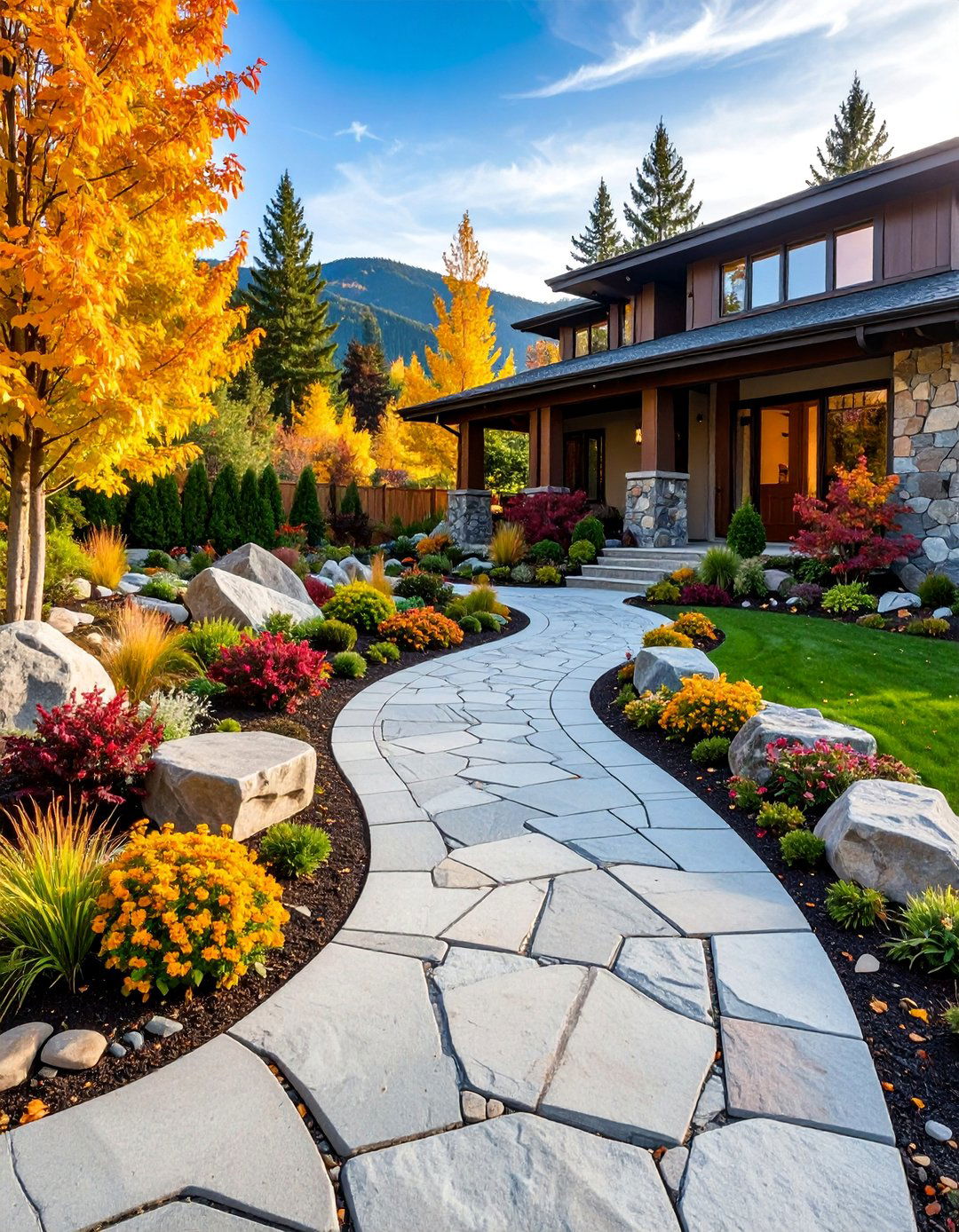
Natural flagstone driveways complemented by alpine rock gardens create dramatic mountain-style landscapes that thrive in challenging conditions. Install irregular flagstone pieces with planted joints using hardy groundcovers like creeping thyme or sedum varieties. Surround the driveway with terraced rock gardens featuring alpine plants such as saxifrage, mountain phlox, and dwarf conifers that tolerate poor soils and extreme temperatures. Large boulders provide structural elements and microclimates for specialized plants while creating visual anchors throughout the landscape. The natural stone surfaces blend seamlessly with rocky terrain while requiring minimal maintenance once established. This approach works well for mountain properties and homes with challenging topography or poor soil conditions.
18. Tar and Chip Driveway with Cottage Garden Plantings
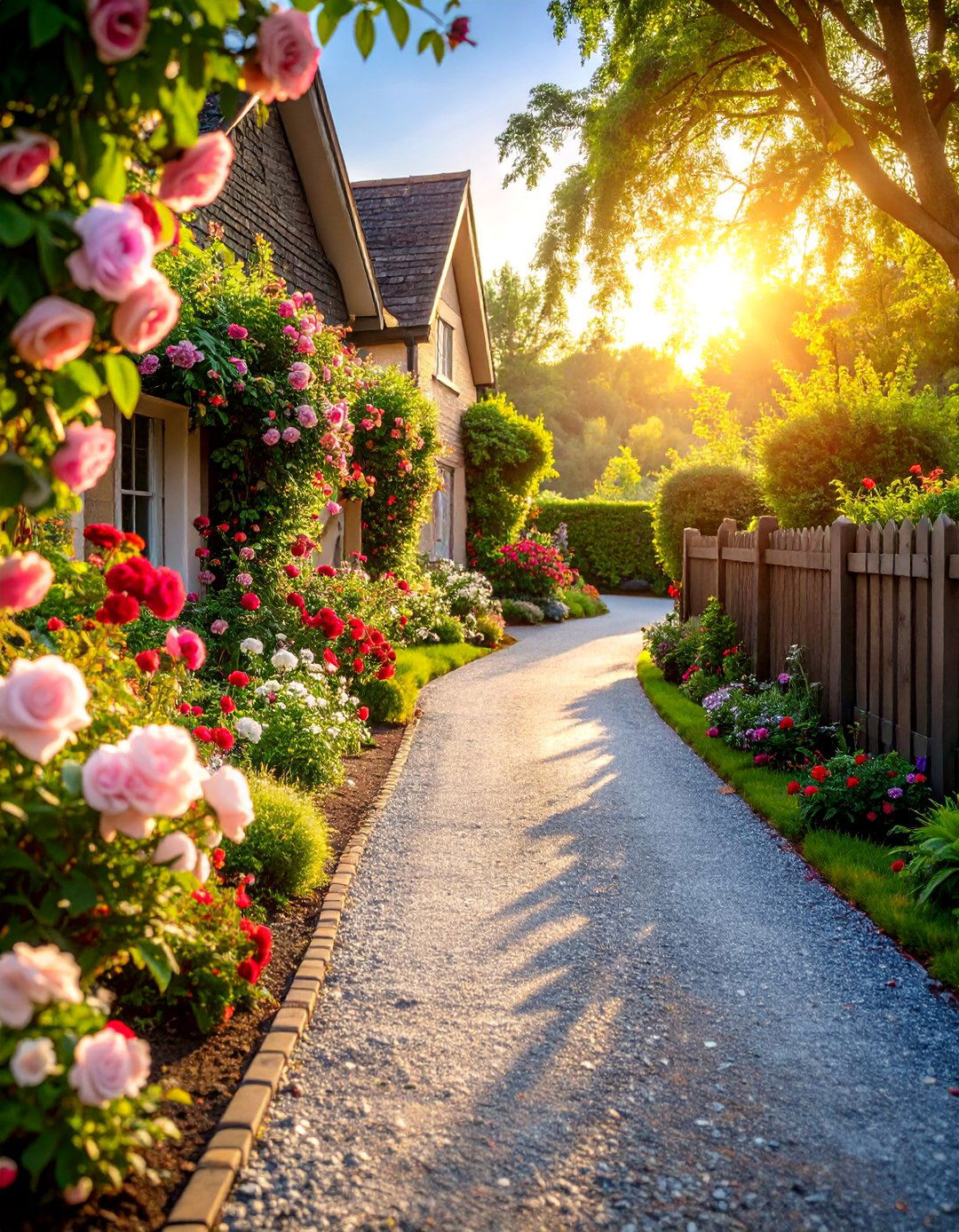
Tar and chip driveways surrounded by cottage garden plantings create charming, informal landscapes that celebrate traditional gardening styles. The textured surface provides excellent traction and weather resistance while planted borders showcase mixed perennials, herbs, and flowering shrubs in relaxed arrangements. Include classics like hollyhocks, foxgloves, sweet peas, and climbing roses for authentic cottage character. Allow plants to self-seed and intermingle naturally while maintaining basic structure through pathways and focal points. Picket fencing or natural stone edging defines garden areas without overwhelming the informal aesthetic. This approach requires regular maintenance but rewards gardeners with abundant flowers, fragrance, and traditional charm that complements farmhouse and cottage architectural styles.
19. Concrete Driveway with Geometric Succulent Patterns

Modern concrete driveways featuring geometric succulent patterns create striking contemporary landscapes that require minimal water and maintenance. Cut precise planting strips or squares into concrete surfaces, filling them with drought-tolerant succulents arranged in repeating patterns or color gradations. Varieties like hens and chicks, echeveria, and sedum create living mosaics that change seasonally through growth and flowering cycles. The geometric arrangement complements modern architecture while providing sustainable landscaping solutions. Use contrasting mulches like colored gravel or decomposed granite to highlight plant arrangements and suppress weeds. Integrated lighting emphasizes the geometric patterns after dark while providing safety illumination. This design approach works particularly well for contemporary homes in water-restricted areas.
20. Shell Driveway with Coastal Garden Plantings
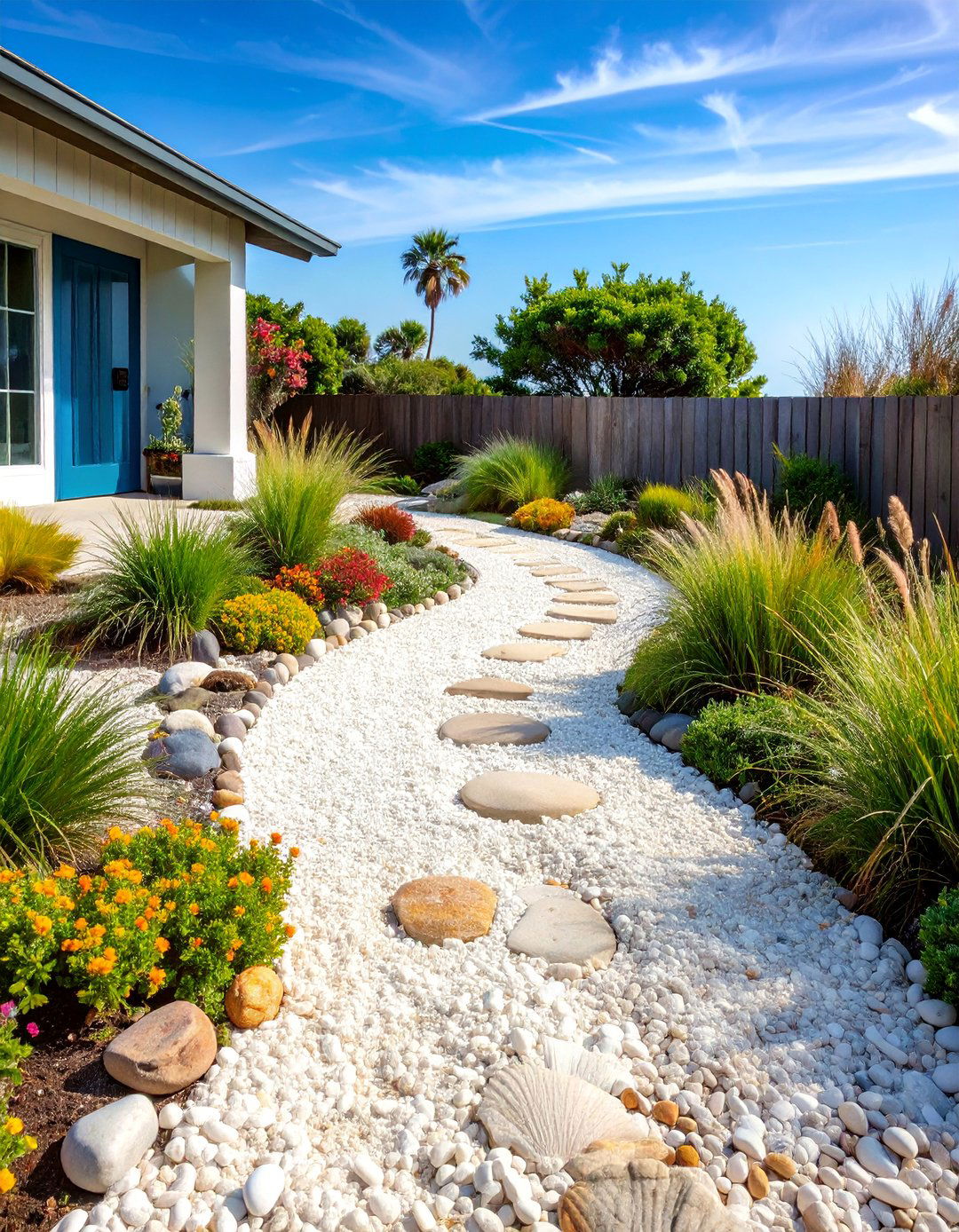
Crushed shell driveways paired with coastal garden plantings create authentic seaside landscapes that thrive in salt air and sandy soils. The shell surface provides excellent drainage and natural color variation while surrounding plantings feature salt-tolerant species like beach grass, sea lavender, and rugosa roses. Include native coastal plants such as bayberry, beach plum, and seaside goldenrod for wildlife habitat and authentic regional character. Driftwood or weathered timber edging enhances the coastal theme while defining planting areas. The natural materials require minimal maintenance while providing sustainable solutions for oceanfront properties. Consider adding ornamental grasses that move with sea breezes and sculptural elements that complement the maritime aesthetic.
21. Recycled Material Driveway with Sustainable Plant Communities

Driveways constructed from recycled materials combined with sustainable plant communities create environmentally responsible landscapes that demonstrate ecological stewardship. Use recycled concrete, reclaimed brick, or sustainable pavers bordered by native plant communities that support local wildlife while requiring minimal inputs. Select regionally appropriate species that provide habitat, erosion control, and seasonal interest without irrigation or chemical treatments. Rain gardens and bioswales integrated into the design manage stormwater naturally while creating educational opportunities. The recycled materials reduce environmental impact while native plantings support biodiversity and ecological function. This approach appeals to environmentally conscious homeowners seeking to reduce their landscape's carbon footprint while creating beautiful, functional outdoor spaces.
22. Colored Concrete Driveway with Monochromatic Plant Schemes

Colored concrete driveways enhanced with monochromatic plant schemes create sophisticated landscapes through careful color coordination and design restraint. Select concrete colors that complement your home's exterior, then choose plants within a single color family for cohesive, elegant results. Silver and gray foliage plants like artemisia, dusty miller, and lamb's ear create subtle sophistication, while green-only schemes emphasize texture and form through varied plant shapes and sizes. The monochromatic approach reduces visual complexity while allowing subtle variations in tone and texture to create interest. Architectural lighting highlights both the colored concrete and plant forms for dramatic evening effects. This design strategy works well for contemporary homes and minimalist landscape preferences.
23. Permeable Concrete Driveway with Stormwater Gardens
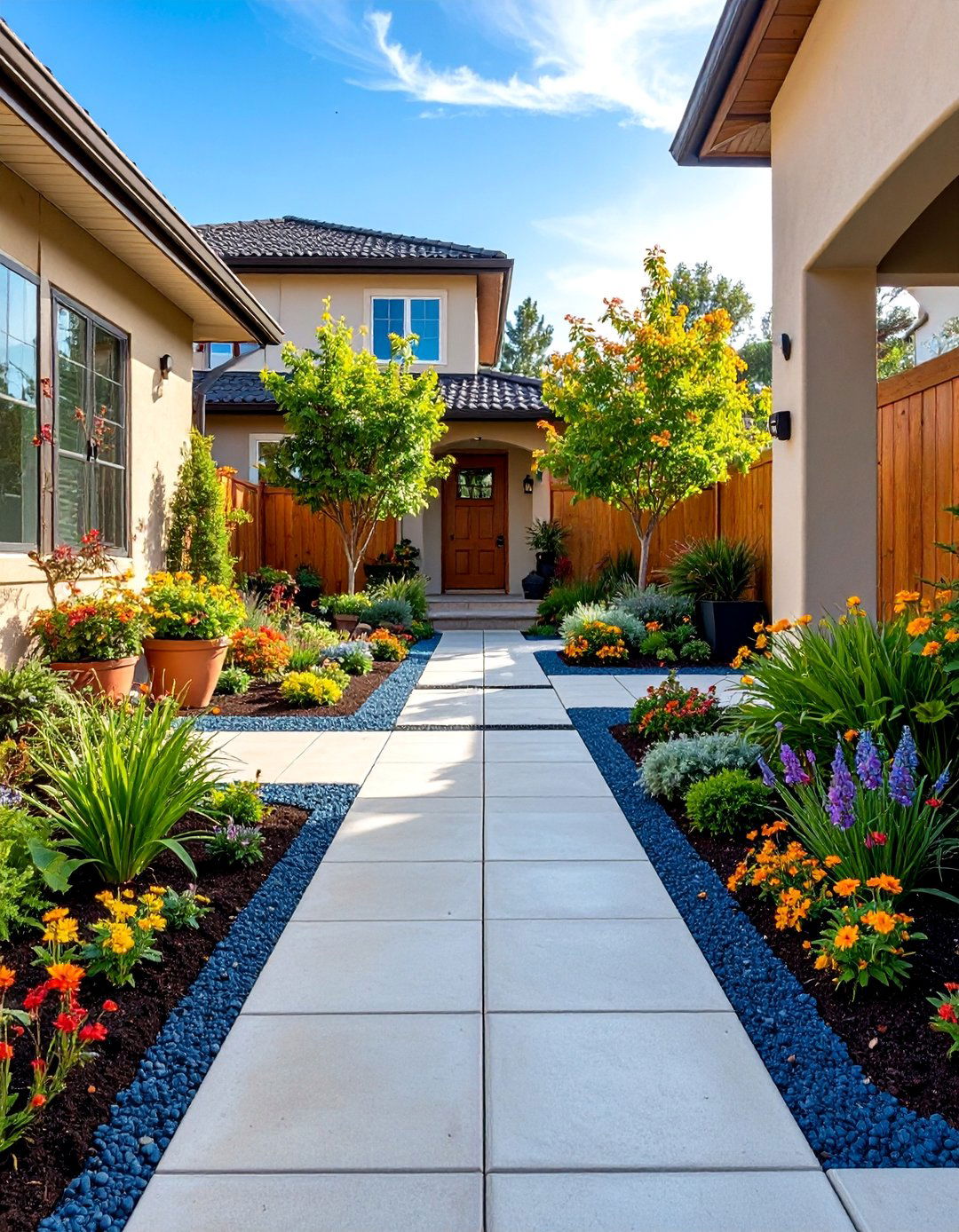
Permeable concrete driveways integrated with stormwater gardens address environmental concerns while creating functional, beautiful landscapes. The porous concrete surface allows water infiltration while maintaining vehicle support, directing overflow to adjacent planted areas designed for temporary flooding. Install moisture-loving plants like cardinal flower, swamp milkweed, and native sedges in depression areas that capture and filter runoff. Dry periods reveal attractive foliage and seed heads while wet conditions support aquatic insects and wildlife. The system reduces flooding, improves water quality, and creates habitat while meeting municipal stormwater requirements. Consider connecting multiple garden areas with meandering pathways or dry creek beds lined with decorative stone.
24. Brick and Stone Combination Driveway with Formal Parterre Gardens

Combination brick and stone driveways featuring formal parterre gardens create grand estate-style entrances that showcase horticultural artistry and design sophistication. Install intricate patterns using contrasting materials like brick infill with stone borders, surrounded by geometric planting beds outlined in low hedging. Traditional parterre plants include boxwood edging filled with seasonal flowers, herbs, or colored foliage plants arranged in symmetrical patterns. The formal design requires regular maintenance but creates impressive focal points suitable for special events and entertaining. Include decorative urns, fountains, or sculptures as central features within the geometric layout. This approach complements classical architecture and formal landscape styles while demonstrating horticultural expertise and attention to detail.
25. Living Driveway with Grass Pavers and Meadow Integration

Living driveways using grass pavers integrated with surrounding meadow plantings create nearly invisible vehicle access that preserves natural landscape character. Install reinforcement grids filled with grass or low-growing groundcovers, surrounded by native meadow plantings that blur the boundary between driveway and natural areas. The grass surface provides vehicle support while maintaining the appearance of continuous grassland or prairie. Surrounding meadow plants like native bunch grasses, wildflowers, and sedges create habitat while requiring minimal maintenance once established. This approach works well for rural properties, environmental demonstration sites, and homeowners seeking to minimize landscape impact while maintaining vehicle access. The living surface reduces heat island effects while supporting local ecology.
Conclusion:
Thoughtful driveway landscaping transforms functional spaces into beautiful entrances that enhance your home's curb appeal and property value. From sustainable permeable surfaces to dramatic lighting features, today's design options accommodate every architectural style and environmental concern. The key lies in selecting materials and plants that complement your home's character while addressing practical needs like drainage, maintenance, and vehicle clearance. Whether you prefer formal geometric designs or naturalistic meadow plantings, successful driveway landscaping creates welcoming first impressions that reflect your personal style and environmental values while providing lasting beauty and functionality.



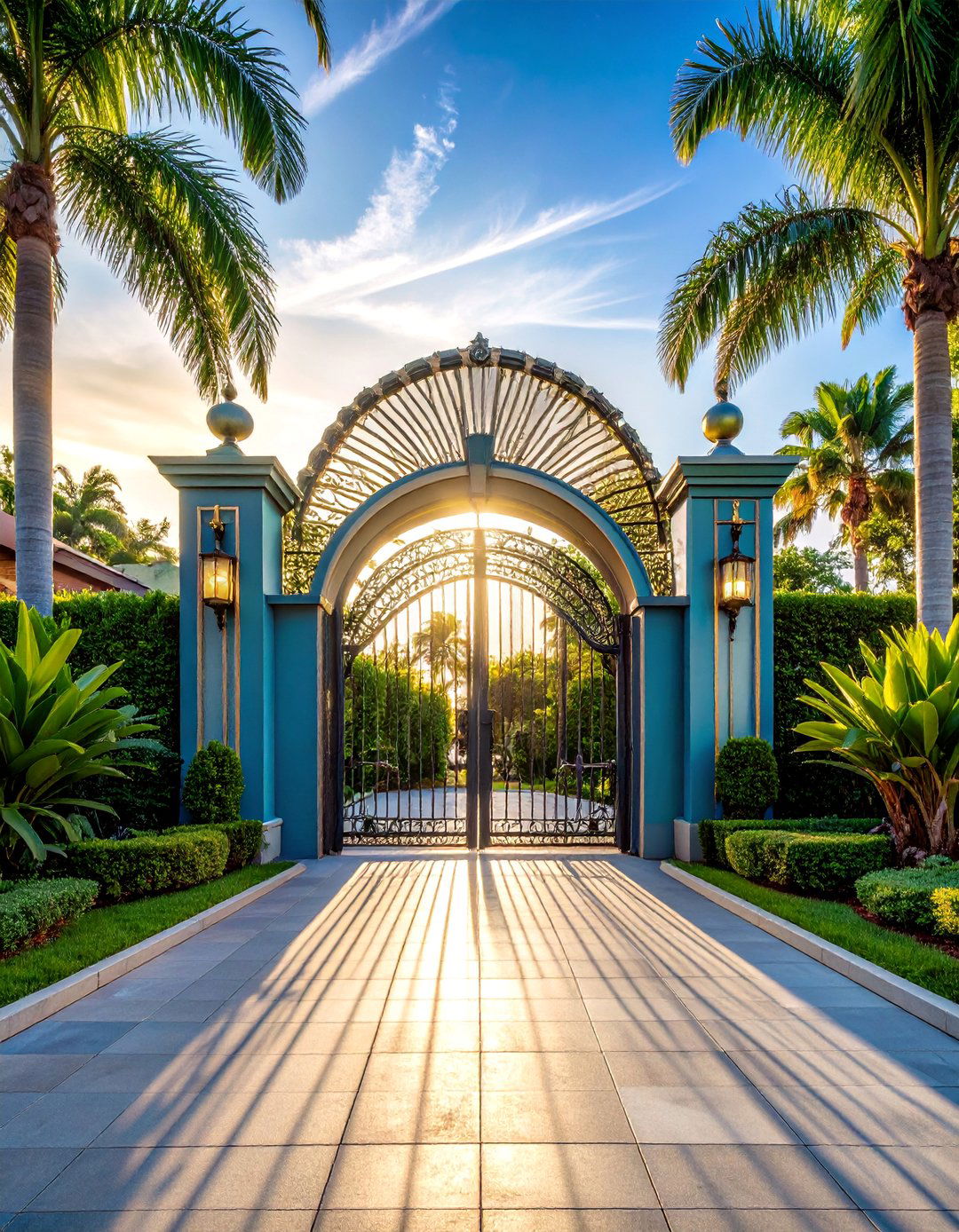



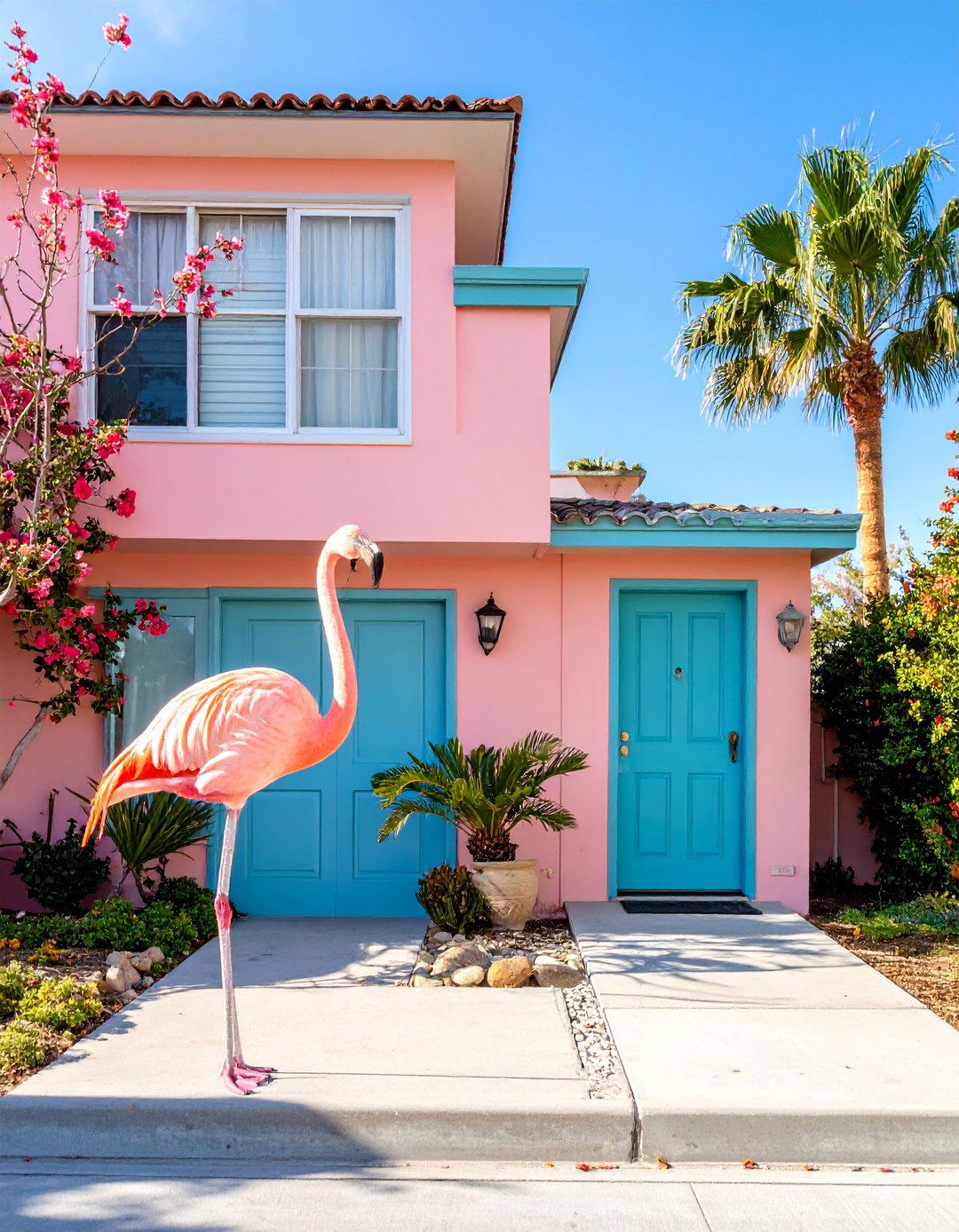
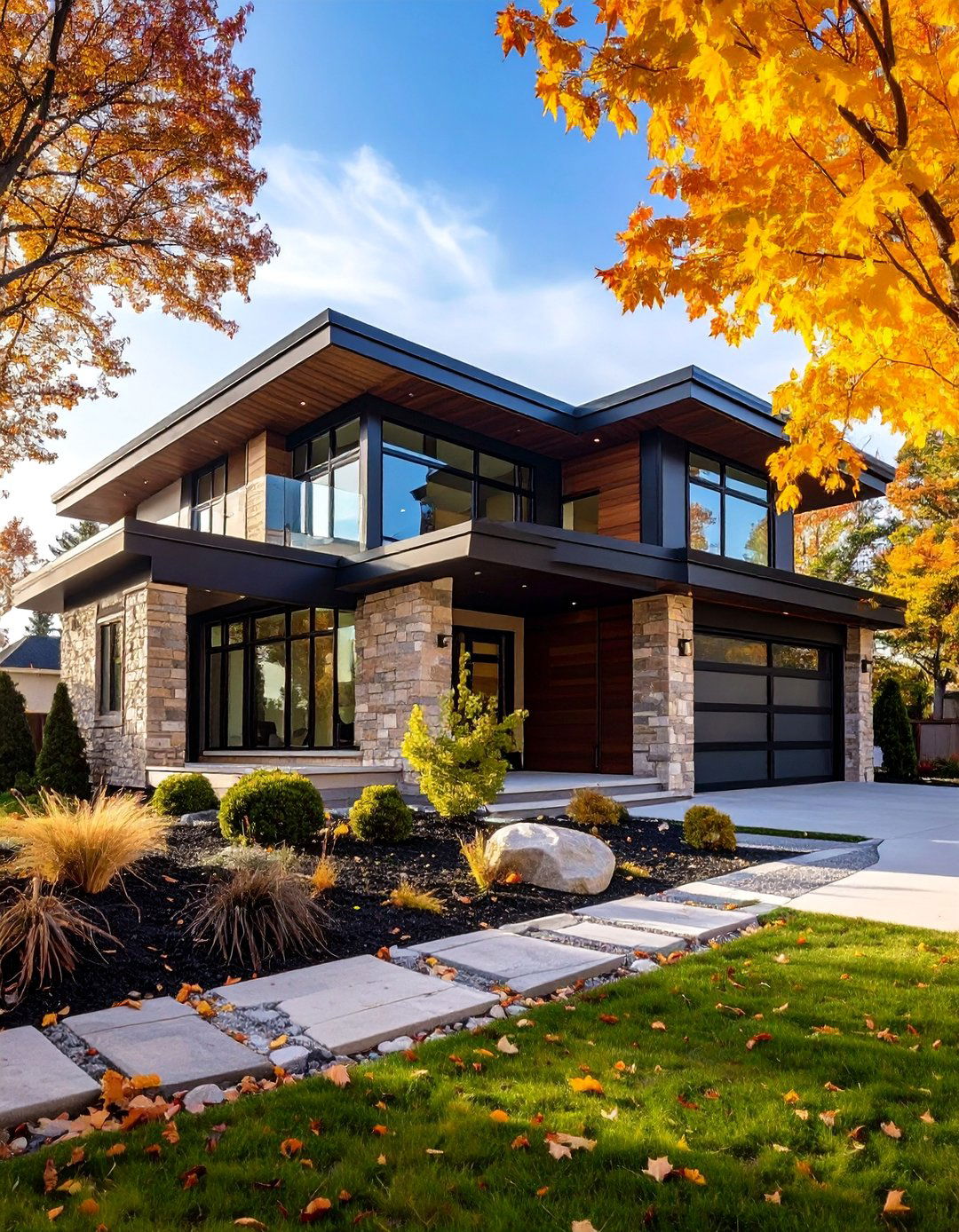


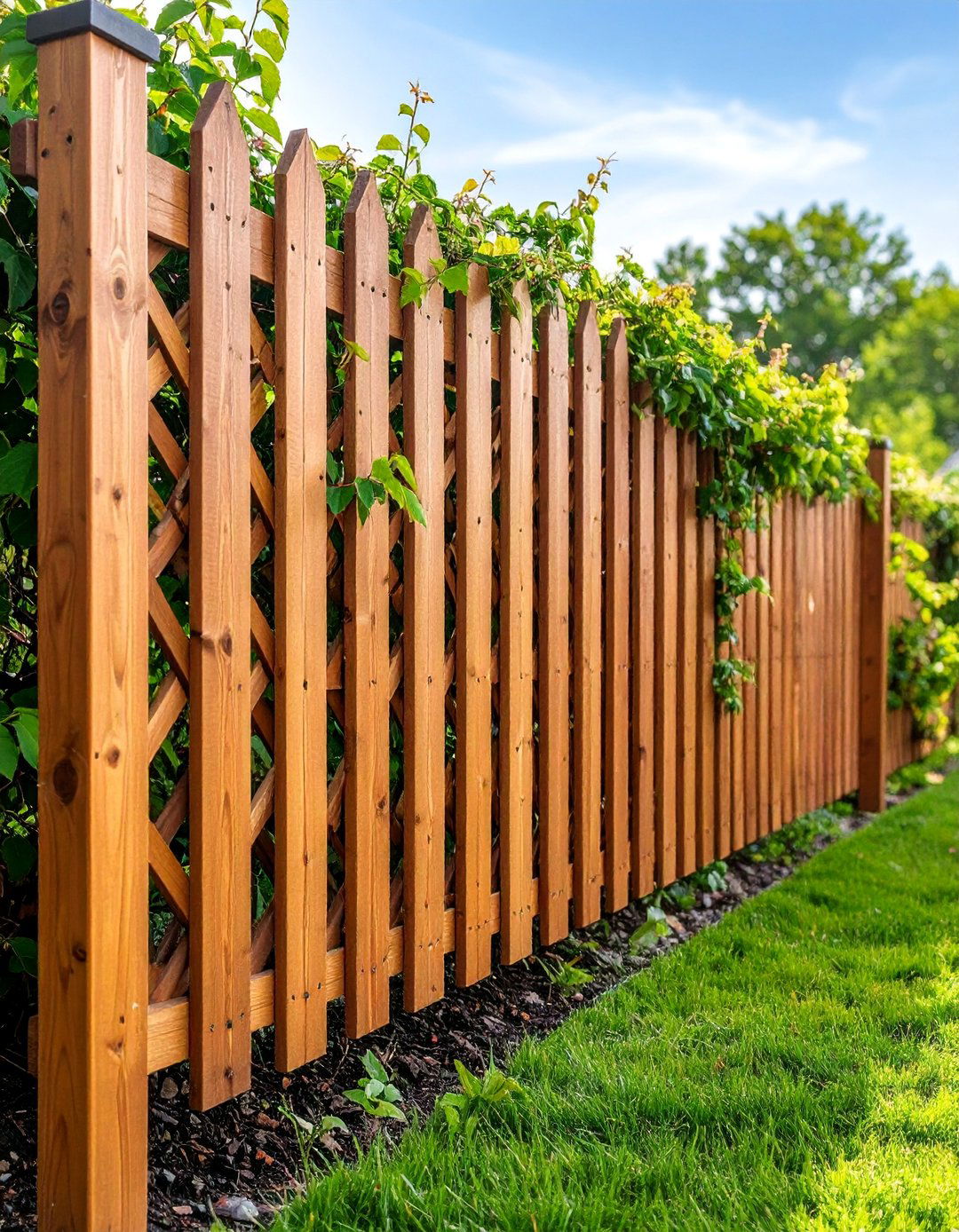
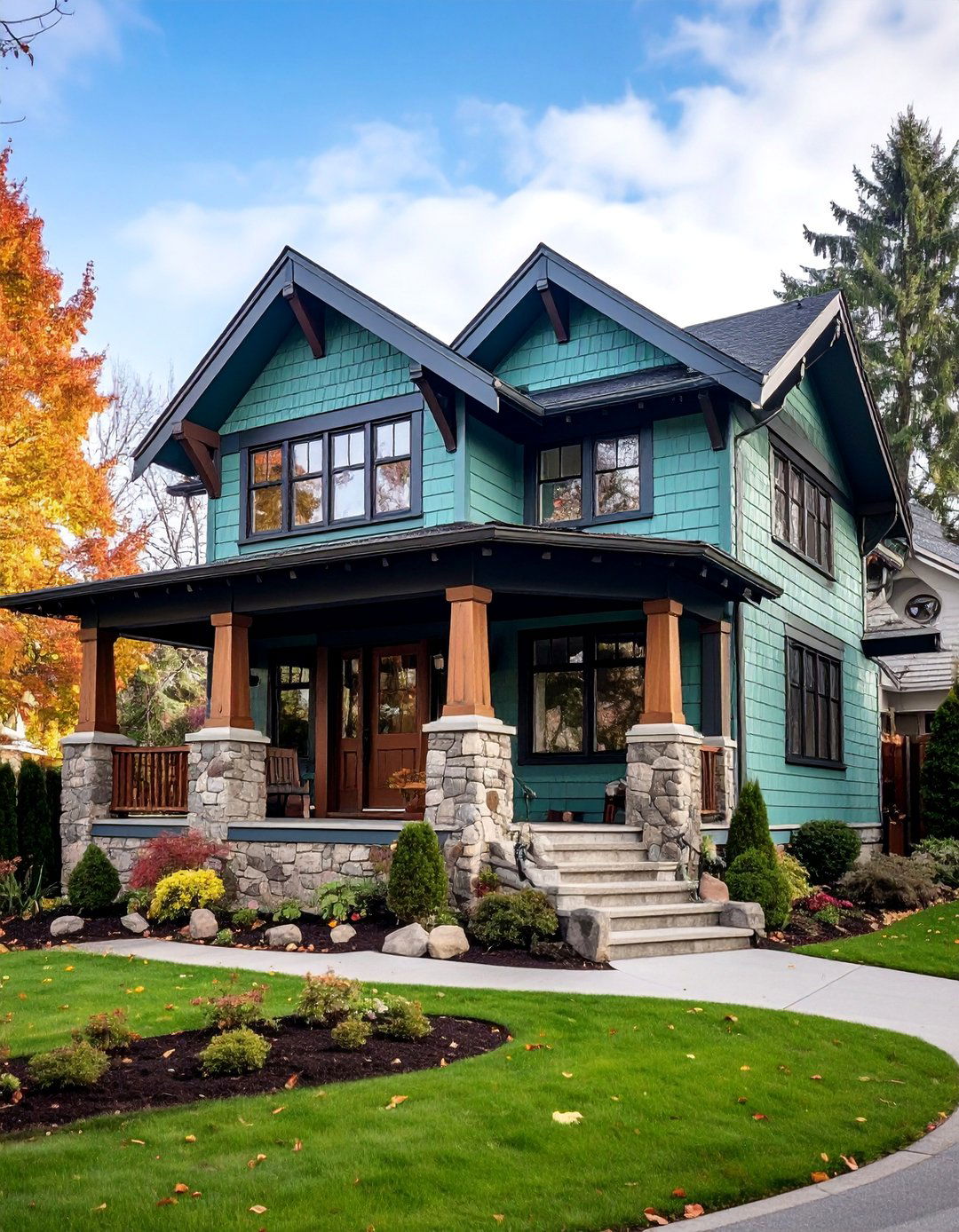
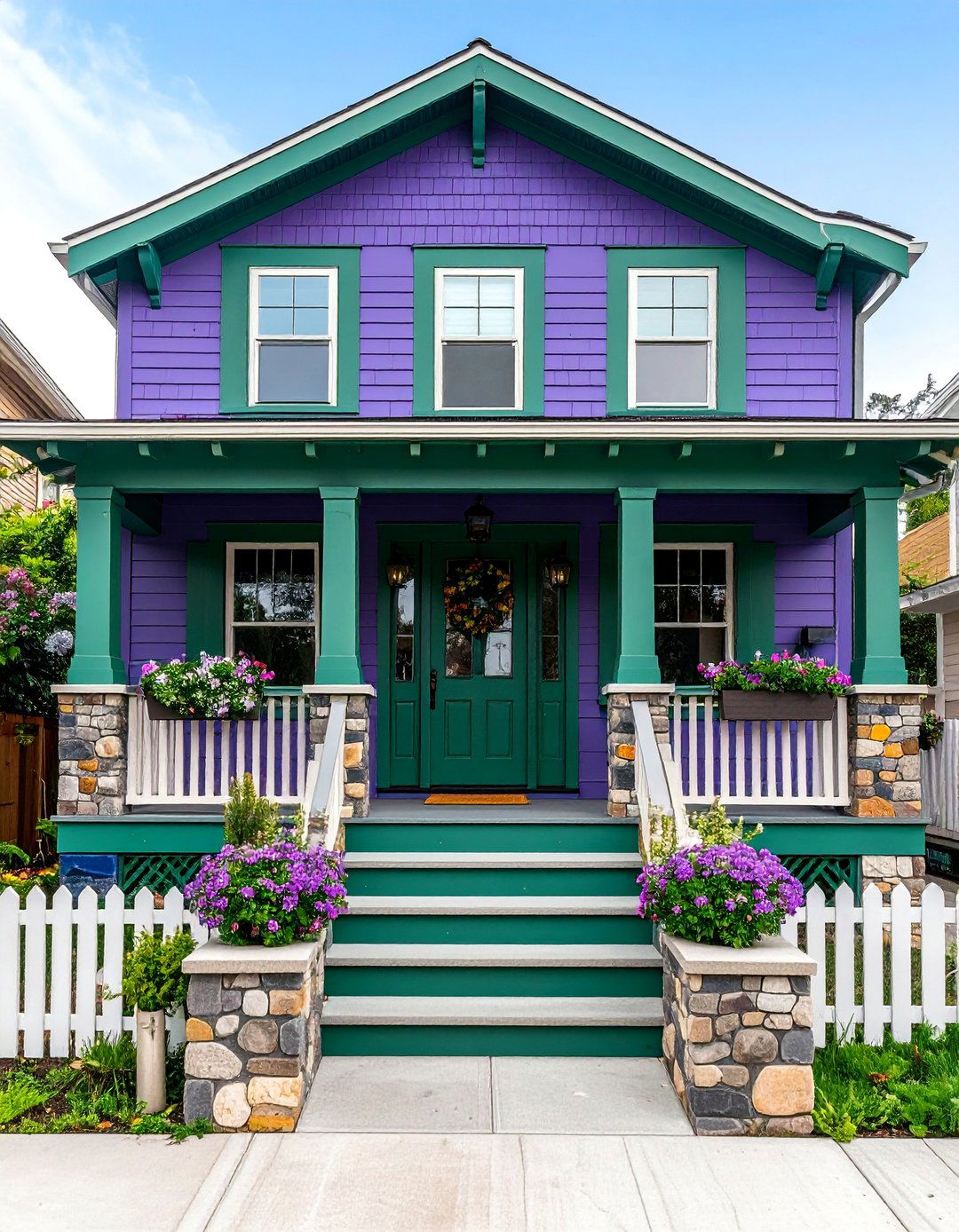
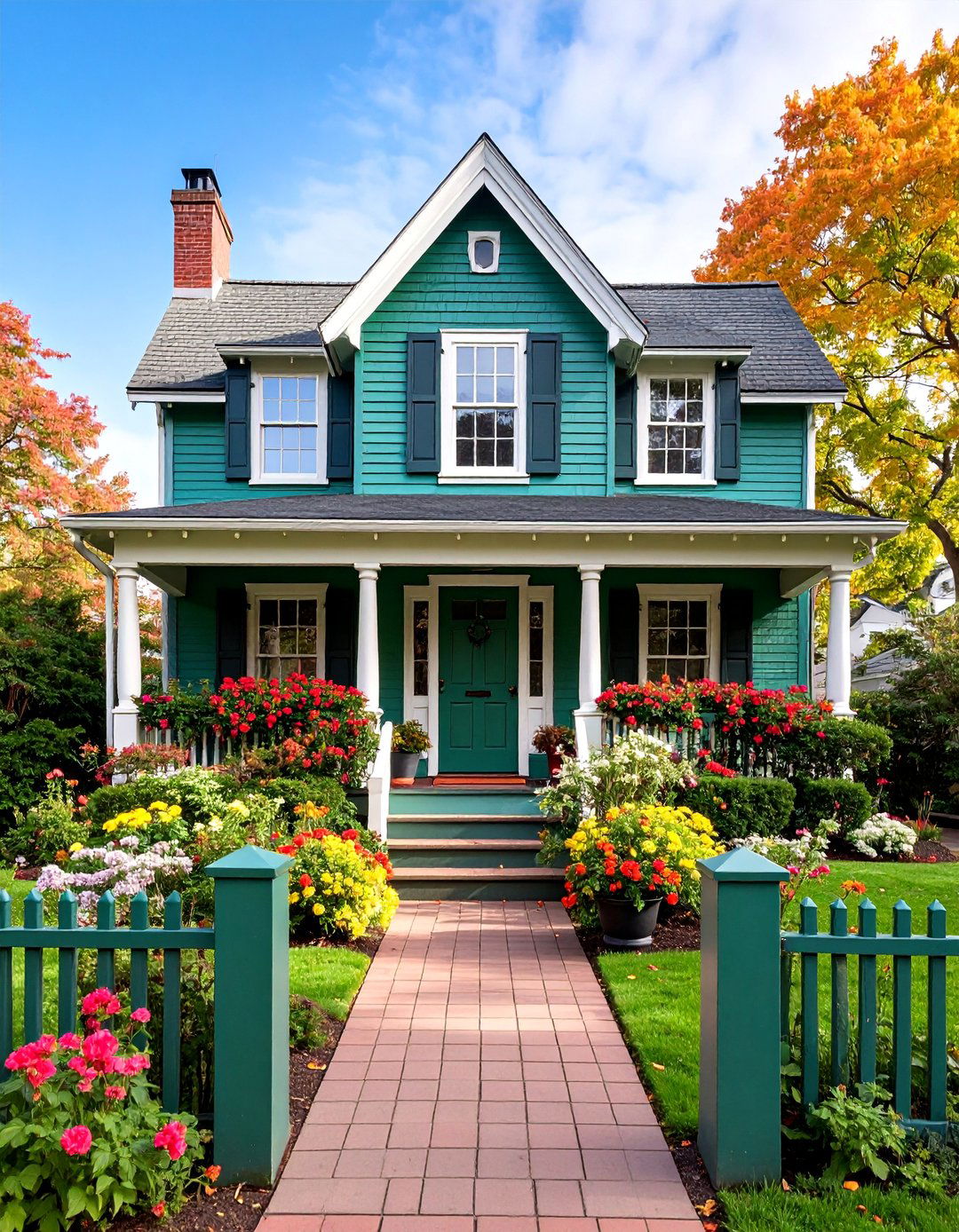

Leave a Reply